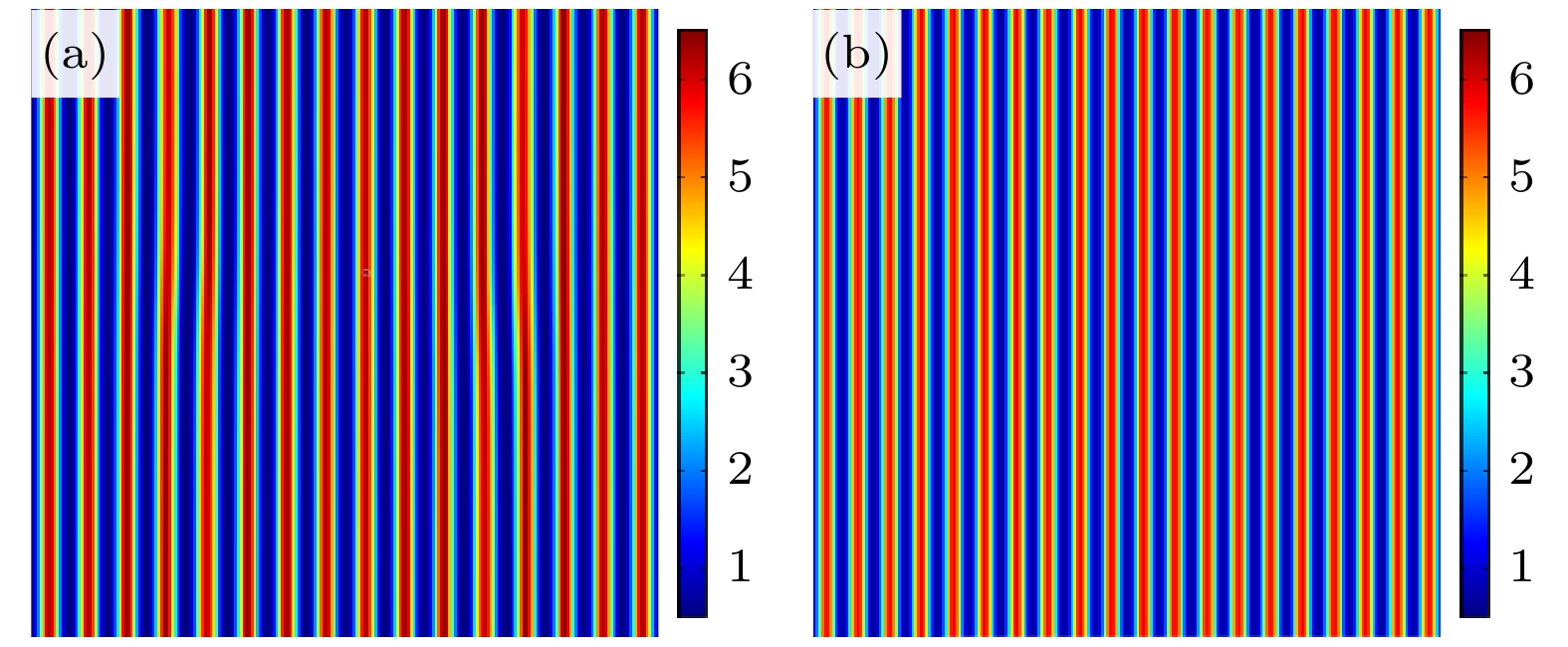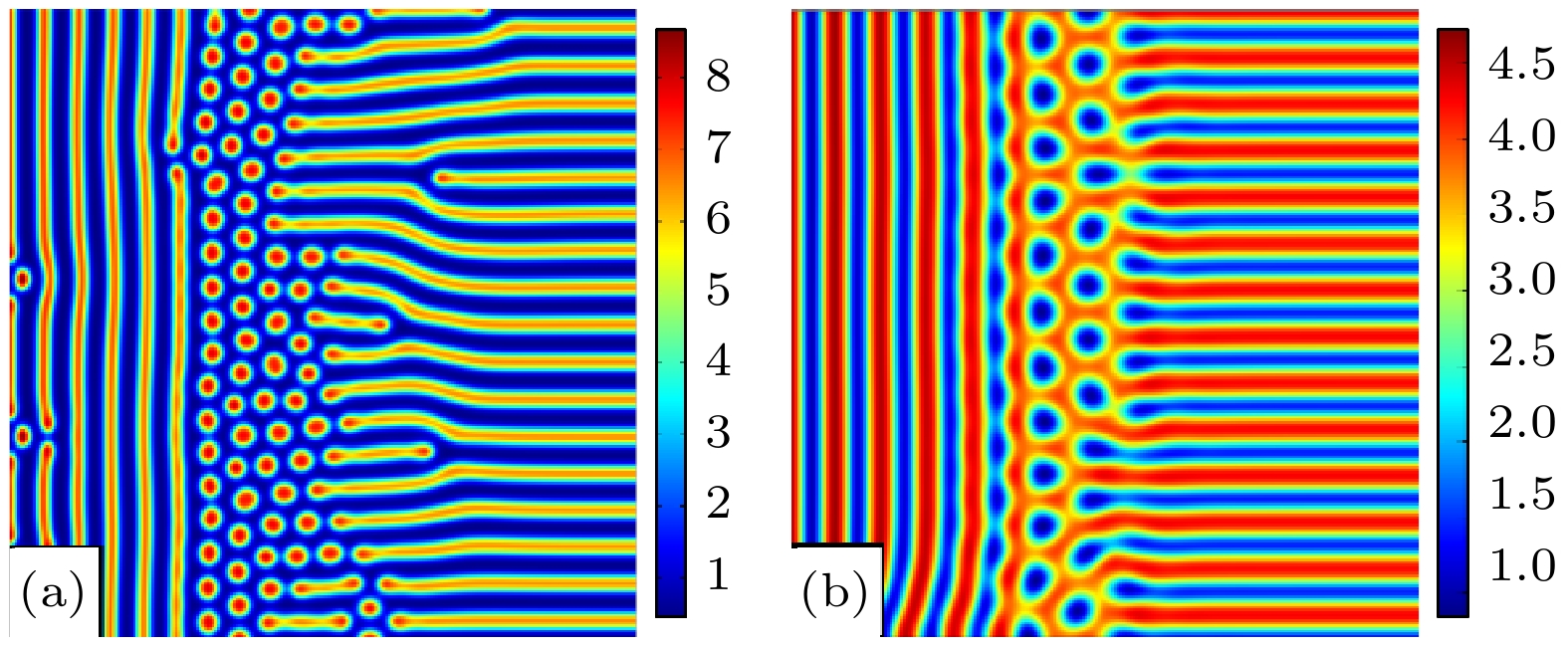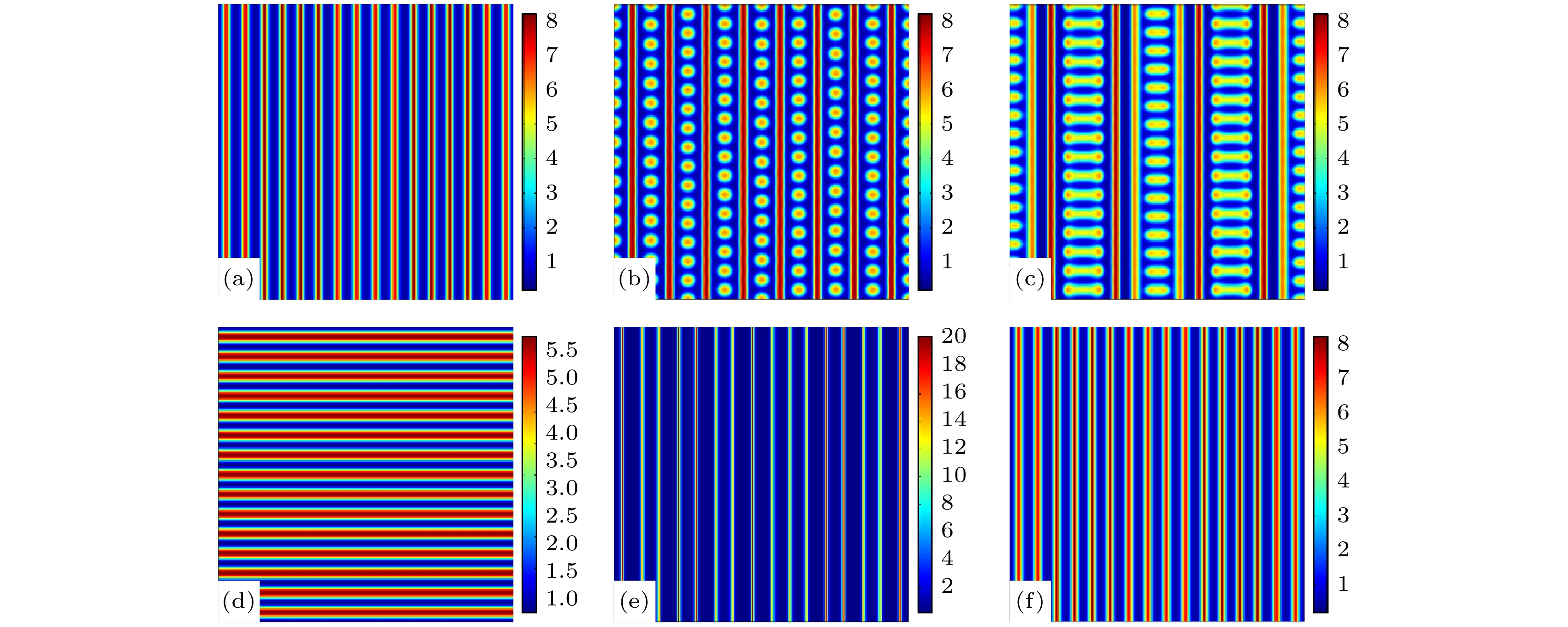-
Diffusion plays a crucial role in the forming and evolving of Turing patterns. Generally, the diffusion processes in complex systems do not comply to the complete random walk theory, which means that the diffusion is abnormal rather than normal, such as super-diffusion, sub-diffusion and anisotropic diffusion. However, most of previous studies focused on the pattern formation mechanism under the normal diffusion. In this paper, a two-component reaction-diffusion model with anisotropic diffusion is used to study the effect of anisotropic diffusion on Turing patterns in heterogeneous environments. Three different types of anisotropic diffusions are utilized. It is shown that the system gives rise to stripe patterns when the degree of anisotropic diffusion is high. The directions of stripes are determined by the degree of the diffusion coefficient deviating from the bifurcation point. In a low degree of anisotropic diffusion, the pattern type is the same as the counterpart in a low degree of the isotropic diffusion. When the diffusion coefficient grows linearly in the space, different types of patterns compete with each other and survive in different regions under the influence of spatial heterogeneity. When the diffusion coefficient is modulated by a one-dimensional periodic function, both type and wavelength of the pattern are determined by the modulated wavelength and the intrinsic wavelength. The system can exhibit alternating two-scale mixed patterns of different types when the modulated wavelength is larger than the intrinsic wavelength. Note that each of the diffusion coefficients of some special anisotropic media is a tensor, which can be expressed as a matrix in two-dimensional cases. We also study the influence of off-diagonal diffusion coefficient D on Turing pattern. It is found that the Turing pattern induced by off-diagonal diffusion coefficient always selects the oblique stripe pattern. The off-diagonal diffusion coefficient D not only affects the pattern selection mechanism, but also expands the parameter range of Turing space. The critical diffusion coefficient
$ {D_{\text{c}}} $ increases linearly with the diagonal diffusion coefficient$ {D_u} $ increasing. The intrinsic wavelength of the oblique stripe pattern decreases as the off-diagonal diffusion coefficient D increases. It is interesting to note that the critical wavelength corresponding to the critical diffusion coefficient$ {D_{\text{c}}} $ is independent of the diagonal diffusion coefficient$ {D_u} $ . These results not only provide a new insight into the formation mechanism of Turing patterns, but also increase the range and complexity of possible patterns.-
Keywords:
- reaction-diffusion system /
- Turing pattern /
- anisotropic diffusion /
- spatial heterogeneity
[1] Fuseya Y, Katsuno H, Behnia K, Kapitulnik A 2021 Nat. Phys. 17 1031
 Google Scholar
Google Scholar
[2] Halatek J, Frey E 2018 Nat. Phys. 14 507
 Google Scholar
Google Scholar
[3] Schweisguth F, Corson F 2019 Dev. Cell 49 659
 Google Scholar
Google Scholar
[4] Cross M C, Hohenberg P C 1993 Rev. Mod. Phys. 65 851
 Google Scholar
Google Scholar
[5] Turing A M 1952 Philos. Trans. R. Soc. London, Ser. B 237 37
 Google Scholar
Google Scholar
[6] Chen J X, Chen Y G, Kapral R 2018 Adv. Sci. 5 1800028
 Google Scholar
Google Scholar
[7] Tan Z, Chen S F, Peng X S, Zhang L, Gao C J 2018 Science 360 518
 Google Scholar
Google Scholar
[8] Buhl J, Sumpter D J T, Couzin I D, Hale J J, Despland E, Miller E R, Simpson S J 2006 Science 312 1402
 Google Scholar
Google Scholar
[9] Haas P A, Goldstein R E 2021 Phys. Rev. Lett. 126 238101
 Google Scholar
Google Scholar
[10] Ouyang Q, Swinney H L 1991 Nature 352 610
 Google Scholar
Google Scholar
[11] Callahan T K, Knobloch E 1999 Physica D 132 339
 Google Scholar
Google Scholar
[12] Landge A N, Jordan B M, Diego X, Muller P 2020 Dev. Biol. 460 2
 Google Scholar
Google Scholar
[13] Si L L, Zhang H T, Wei J P, Li B, Han H K 2021 Fuel 284 118887
 Google Scholar
Google Scholar
[14] Lin F J, Liao J J, Wu J C, Ai B Q 2022 Chin. Phys. B 31 036401
 Google Scholar
Google Scholar
[15] Zhou F L, McHugh D J, Li Z X, Gough J E, Williams G R, Parker G J M 2021 Bioinspir. Biomim. 16 046016
 Google Scholar
Google Scholar
[16] Chen C N, Ei S I, Lin Y P, Kung S Y 2011 Comm. Part. Diff. Eq. 36 998
 Google Scholar
Google Scholar
[17] Kolokolnikov T, Ward M, Tzou J, Wei J C 2018 Phil. Trans. R. Soc. A 376 20180110
 Google Scholar
Google Scholar
[18] Gao Y P, Zhang Y F, Schwen D, Jiang C, Gan J 2019 Sci. Rep. 9 7835
 Google Scholar
Google Scholar
[19] Bar M, Hagberg A, Meron E, Thiele U 1999 Phys. Rev. Lett. 83 2664
 Google Scholar
Google Scholar
[20] He Z Z, Liu J 2010 Ann. Phys. 325 359
 Google Scholar
Google Scholar
[21] Cui R F, Chen Q H, Chen J X 2020 Nanoscale 12 12275
 Google Scholar
Google Scholar
[22] Bose I, Chaudhuri I 1997 Phys. Rev. E 55 5291
 Google Scholar
Google Scholar
[23] Busiello D M, Planchon G, Asllani M, Carletti T, Fanelli D 2015 Eur. Phys. J. B 88 222
 Google Scholar
Google Scholar
[24] Shoji H, Iwasa Y, Mochizuki A, Kondo S 2002 J. Theor. Biol. 214 549
 Google Scholar
Google Scholar
[25] Shoji H, Mochizuki A, Iwasa Y, Hirata M, Watanabe T, Hioki S, Kondo S 2003 Dev. Dyn. 226 627
 Google Scholar
Google Scholar
[26] Hiscock T W, Megason S G 2015 Cell Syst. 1 408
 Google Scholar
Google Scholar
[27] Van Gorder R A 2021 Phil. Trans. R. Soc. A 379 20210001
 Google Scholar
Google Scholar
[28] Kozak M, Gaffney E A, Klika V 2019 Phys. Rev. E 100 042220
 Google Scholar
Google Scholar
[29] Glimm T, Zhang J Y, Shen Y Q 2009 Nonlinearity 22 2541
 Google Scholar
Google Scholar
[30] Page K, Maini P K, Monk N A M 2003 Physica D 181 80
 Google Scholar
Google Scholar
[31] Page K M, Maini P K, Monk N A M 2005 Physica D 202 95
 Google Scholar
Google Scholar
[32] Li W S, Hu W Y, Pang Y C, Liu T R, Zhong W R, Shao Y Z 2012 Phys. Rev. E 85 066132
 Google Scholar
Google Scholar
[33] 胡文勇, 邵元智 2014 物理学报 63 238202
 Google Scholar
Google Scholar
Hu W Y, Shao Y Z 2014 Acta Phys. Sin. 63 238202
 Google Scholar
Google Scholar
[34] Chen W Q, Zhang H, Ying H P, Li B W, Chen J X 2007 J. Chem. Phys. 127 154708
 Google Scholar
Google Scholar
[35] Prigogine I, Lefever R 1968 J. Chem. Phys. 48 1695
 Google Scholar
Google Scholar
[36] Pena B, Perez-Garcia C 2001 Phys. Rev. E 64 056213
 Google Scholar
Google Scholar
[37] Rajkovic M, Milovanovic M, Skoric M M 2017 Phys. Plasmas 24 052303
 Google Scholar
Google Scholar
[38] Hastings A, Abbott K C, Cuddington K, Francis T, Gellner G, Lai Y C, Morozov A, Petrovskii S, Scranton K, Zeeman M L 2018 Science 361 eaat6412
 Google Scholar
Google Scholar
-
图 1 各向同性扩散下的色散曲线图及其相应的图灵斑图 (a)色散曲线; (b)点状六边形斑图,
$ {D_u} = 2 $ ; (c)条纹斑图,$ {D_u} = 3 $ ; (d)蜂窝状六边形斑图,$ {D_u} = 4 $ Figure 1. Dispersion curves under isotropic diffusion and their corresponding Turing patterns: (a) Dispersion curves; (b) hexagonal spot pattern,
$ {D_u} = 2 $ ; (c) stripe pattern,$ {D_u} = 3 $ ; (d) honeycomb hexagonal pattern,$ {D_u} = 4 $ .图 2 各向异性扩散下的条纹斑图 (a)竖直取向条纹,
$D_u^{\left( x \right)} = 2$ ,$D_u^{\left( y \right)} = 5$ ; (b)竖直取向条纹,$D_u^{\left( x \right)} = 2$ ,$D_u^{\left( y \right)} = 4$ Figure 2. Stripe patterns under anisotropic diffusion: (a) Vertically oriented stripes,
$ D_u^{\left( x \right)} = 2 $ ,$ D_u^{\left( y \right)} = 5 $ ; (b) vertically oriented stripes,$ D_u^{\left( x \right)} = 2 $ ,$ D_u^{\left( y \right)} = 4 $ .图 3 扩散系数在
$ x $ 方向单调增加时的混合斑图 (a)点状六边形与条纹混合斑图,$ D_u^{\left( x \right)} = 1.5 + 0.01 x $ ,$ D_u^{\left( y \right)} = 2 $ ; (b)蜂窝状六边形与条纹混合斑图,$ D_u^{\left( x \right)} = 3.5 + 0.01 x $ ,$ D_u^{\left( y \right)} = 4 $ Figure 3. Mixed patterns with a monotonic increase in the
$ x $ direction: (a) Pattern of dot-like hexagons mixed with stripes,$ D_u^{\left( x \right)} = 1.5 + 0.01 x $ ,$ D_u^{\left( y \right)} = 2 $ ; (b) honeycomb hexagonal and stripe mixed pattern,$ D_u^{\left( x \right)} = 3.5 + 0.01 x $ ,$ D_u^{\left( y \right)} = 4 $ .图 4 扩散系数在
$ x $ 方向按$ D_u^{\left( x \right)} = \gamma \cos ({{2{\text{π }}nx} \mathord{\left/ {\vphantom {{2{\text{π }}nx} L}} \right. } L}) + {D_{u0}} $ 周期性变化时的图灵斑图 (a)调制条纹斑图,$ \gamma = 1.5 $ ,$ n = 16 $ ,$ {D_{u0}} = 2.5 $ ,$ D_u^{\left( y \right)}{\text{ = 3}} $ ; (b)双尺度点线相间斑图,$ \gamma = 1.5 $ ,$ n = 8 $ ,$ {D_{u0}} = 2.5 $ ,$ D_u^{\left( y \right)}{\text{ = 3}} $ ; (c)点线相间斑图,$ \gamma = 1.5 $ ,$ n = 4 $ ,$ {D_{u0}} = 2.5 $ ,$ D_u^{\left( y \right)}{\text{ = 3}} $ ; (d)水平取向条纹,$ \gamma = 1.5 $ ,$ n = 16 $ ,$ {D_{u0}} = 7 $ ,$ D_u^{\left( y \right)}{\text{ = 3}} $ ; (e)调制条纹斑图,$ \gamma = 2.3 $ ,$ n = 16 $ ,$ {D_{u0}} = 2.5 $ ,$ D_u^{\left( y \right)}{\text{ = 3}} $ ; (f)调制条纹斑图,$ \gamma = 1.5 $ ,$ n = 16 $ ,$ {D_{u0}} = 2.5 $ ,$ D_u^{\left( y \right)} = 5 $ Figure 4. Turing patterns with periodically modulated diffusion coefficient
$ D_u^{\left( x \right)} = \gamma \cos ({{2{\text{π }}nx} \mathord{\left/ {\vphantom {{2{\text{π }}nx} L}} \right. } L}) + {D_{u0}} $ in the$ x $ direction: (a) Modulated stripe pattern,$ \gamma = 1.5 $ ,$ n = 16 $ ,$ {D_{u0}} = 2.5 $ ,$ D_u^{\left( y \right)}{\text{ = 3}} $ ; (b) two-scale spots-stripes pattern,$ \gamma = 1.5 $ ,$ n = 8 $ ,$ {D_{u0}} = 2.5 $ ,$ D_u^{\left( y \right)}{\text{ = 3}} $ ; (c) spots-stripes pattern,$ \gamma = 1.5 $ ,$ n = 4 $ ,$ {D_{u0}} = 2.5 $ ,$ D_u^{\left( y \right)}{\text{ = 3}} $ ; (d) horizontally oriented stripes,$ \gamma = 1.5 $ ,$ n = 16 $ ,$ {D_{u0}} = 7 $ ,$ D_u^{\left( y \right)}{\text{ = 3}} $ ; (e) modulated stripe pattern,$ \gamma = 2.3 $ ,$ n = 16 $ ,$ {D_{u0}} = 2.5 $ ,$ D_u^{\left( y \right)}{\text{ = 3}} $ ; (f) modulated stripe pattern,$ \gamma = 1.5 $ ,$ n = 16 $ ,$ {D_{u0}} = 2.5 $ ,$ D_u^{\left( y \right)} = 5 $ .图 5 扩散系数在
$ x $ 方向按$ D_u^{\left( x \right)} = \gamma \cos ({{2{\text{π }}nx} \mathord{\left/ {\vphantom {{2{\text{π }}nx} L}} \right. } L}) + {D_{u0}} $ 周期性变化时的复杂条纹斑图($ \gamma = 1.5 $ ,$ {D_{u0}} = 2.5 $ ,$ D_u^{\left( y \right)} = 5 $ ) (a)$n = $ $ 4$ ; (b)$ n = 8 $ ; (c)$ n = 16 $ Figure 5. Complex stripe patterns with periodically modulated diffusion coefficient
$ D_u^{\left( x \right)} = \gamma \cos ({{2{\text{π }}nx} \mathord{\left/ {\vphantom {{2{\text{π }}nx} L}} \right. } L}) + {D_{u0}} $ in the$ x $ direction, where$ \gamma = 1.5 $ ,$ {D_{u0}} = 2.5 $ ,$ D_u^{\left( y \right)} = 5 $ : (a)$ n = 4 $ ; (b)$ n = 8 $ ; (c)$ n = 16 $ .图 6 非对角扩散系数
$ D $ 对斑图的影响 (a)斜条纹,$ D_u^{} = 2 $ ,$ D = 1 $ ; (b)斜条纹,$ D_u^{} = 5 $ ,$ D = 1 $ ; (c)扩散系数$ {D_u} $ 与临界扩散系数$ {D_{\text{c}}} $ 的关系曲线图; (d)扩散系数$ D $ 与波长$ \lambda $ 的关系曲线图Figure 6. Effect of off-diagonal diffusion coefficient
$ D $ on the pattern: (a) Oblique stripes,$ D_u^{} = 2 $ ,$ D = 1 $ ; (b) oblique stripes,$ D_u^{} = 5 $ ,$ D = 1 $ ; (c) the relationship between the diffusion coefficient$ {D_u} $ and the critical diffusion coefficient$ {D_{\text{c}}} $ ; (d) the relationship between the diffusion coefficient$ D $ and the wavelength$ \lambda $ . -
[1] Fuseya Y, Katsuno H, Behnia K, Kapitulnik A 2021 Nat. Phys. 17 1031
 Google Scholar
Google Scholar
[2] Halatek J, Frey E 2018 Nat. Phys. 14 507
 Google Scholar
Google Scholar
[3] Schweisguth F, Corson F 2019 Dev. Cell 49 659
 Google Scholar
Google Scholar
[4] Cross M C, Hohenberg P C 1993 Rev. Mod. Phys. 65 851
 Google Scholar
Google Scholar
[5] Turing A M 1952 Philos. Trans. R. Soc. London, Ser. B 237 37
 Google Scholar
Google Scholar
[6] Chen J X, Chen Y G, Kapral R 2018 Adv. Sci. 5 1800028
 Google Scholar
Google Scholar
[7] Tan Z, Chen S F, Peng X S, Zhang L, Gao C J 2018 Science 360 518
 Google Scholar
Google Scholar
[8] Buhl J, Sumpter D J T, Couzin I D, Hale J J, Despland E, Miller E R, Simpson S J 2006 Science 312 1402
 Google Scholar
Google Scholar
[9] Haas P A, Goldstein R E 2021 Phys. Rev. Lett. 126 238101
 Google Scholar
Google Scholar
[10] Ouyang Q, Swinney H L 1991 Nature 352 610
 Google Scholar
Google Scholar
[11] Callahan T K, Knobloch E 1999 Physica D 132 339
 Google Scholar
Google Scholar
[12] Landge A N, Jordan B M, Diego X, Muller P 2020 Dev. Biol. 460 2
 Google Scholar
Google Scholar
[13] Si L L, Zhang H T, Wei J P, Li B, Han H K 2021 Fuel 284 118887
 Google Scholar
Google Scholar
[14] Lin F J, Liao J J, Wu J C, Ai B Q 2022 Chin. Phys. B 31 036401
 Google Scholar
Google Scholar
[15] Zhou F L, McHugh D J, Li Z X, Gough J E, Williams G R, Parker G J M 2021 Bioinspir. Biomim. 16 046016
 Google Scholar
Google Scholar
[16] Chen C N, Ei S I, Lin Y P, Kung S Y 2011 Comm. Part. Diff. Eq. 36 998
 Google Scholar
Google Scholar
[17] Kolokolnikov T, Ward M, Tzou J, Wei J C 2018 Phil. Trans. R. Soc. A 376 20180110
 Google Scholar
Google Scholar
[18] Gao Y P, Zhang Y F, Schwen D, Jiang C, Gan J 2019 Sci. Rep. 9 7835
 Google Scholar
Google Scholar
[19] Bar M, Hagberg A, Meron E, Thiele U 1999 Phys. Rev. Lett. 83 2664
 Google Scholar
Google Scholar
[20] He Z Z, Liu J 2010 Ann. Phys. 325 359
 Google Scholar
Google Scholar
[21] Cui R F, Chen Q H, Chen J X 2020 Nanoscale 12 12275
 Google Scholar
Google Scholar
[22] Bose I, Chaudhuri I 1997 Phys. Rev. E 55 5291
 Google Scholar
Google Scholar
[23] Busiello D M, Planchon G, Asllani M, Carletti T, Fanelli D 2015 Eur. Phys. J. B 88 222
 Google Scholar
Google Scholar
[24] Shoji H, Iwasa Y, Mochizuki A, Kondo S 2002 J. Theor. Biol. 214 549
 Google Scholar
Google Scholar
[25] Shoji H, Mochizuki A, Iwasa Y, Hirata M, Watanabe T, Hioki S, Kondo S 2003 Dev. Dyn. 226 627
 Google Scholar
Google Scholar
[26] Hiscock T W, Megason S G 2015 Cell Syst. 1 408
 Google Scholar
Google Scholar
[27] Van Gorder R A 2021 Phil. Trans. R. Soc. A 379 20210001
 Google Scholar
Google Scholar
[28] Kozak M, Gaffney E A, Klika V 2019 Phys. Rev. E 100 042220
 Google Scholar
Google Scholar
[29] Glimm T, Zhang J Y, Shen Y Q 2009 Nonlinearity 22 2541
 Google Scholar
Google Scholar
[30] Page K, Maini P K, Monk N A M 2003 Physica D 181 80
 Google Scholar
Google Scholar
[31] Page K M, Maini P K, Monk N A M 2005 Physica D 202 95
 Google Scholar
Google Scholar
[32] Li W S, Hu W Y, Pang Y C, Liu T R, Zhong W R, Shao Y Z 2012 Phys. Rev. E 85 066132
 Google Scholar
Google Scholar
[33] 胡文勇, 邵元智 2014 物理学报 63 238202
 Google Scholar
Google Scholar
Hu W Y, Shao Y Z 2014 Acta Phys. Sin. 63 238202
 Google Scholar
Google Scholar
[34] Chen W Q, Zhang H, Ying H P, Li B W, Chen J X 2007 J. Chem. Phys. 127 154708
 Google Scholar
Google Scholar
[35] Prigogine I, Lefever R 1968 J. Chem. Phys. 48 1695
 Google Scholar
Google Scholar
[36] Pena B, Perez-Garcia C 2001 Phys. Rev. E 64 056213
 Google Scholar
Google Scholar
[37] Rajkovic M, Milovanovic M, Skoric M M 2017 Phys. Plasmas 24 052303
 Google Scholar
Google Scholar
[38] Hastings A, Abbott K C, Cuddington K, Francis T, Gellner G, Lai Y C, Morozov A, Petrovskii S, Scranton K, Zeeman M L 2018 Science 361 eaat6412
 Google Scholar
Google Scholar
Catalog
Metrics
- Abstract views: 7239
- PDF Downloads: 108
- Cited By: 0























 DownLoad:
DownLoad:














































































































